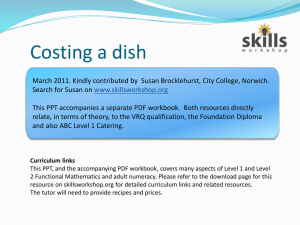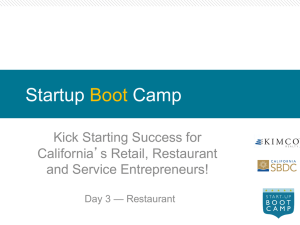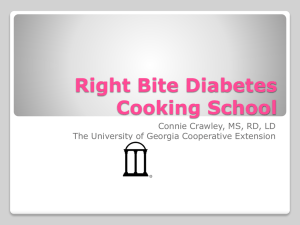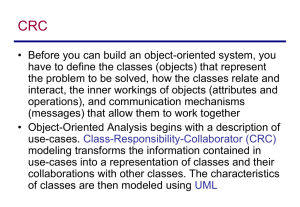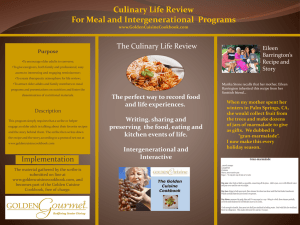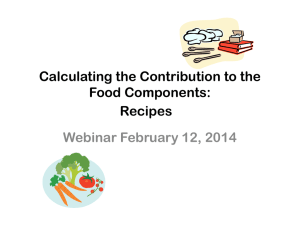FBM CH 7 - Costs and Pricing
advertisement
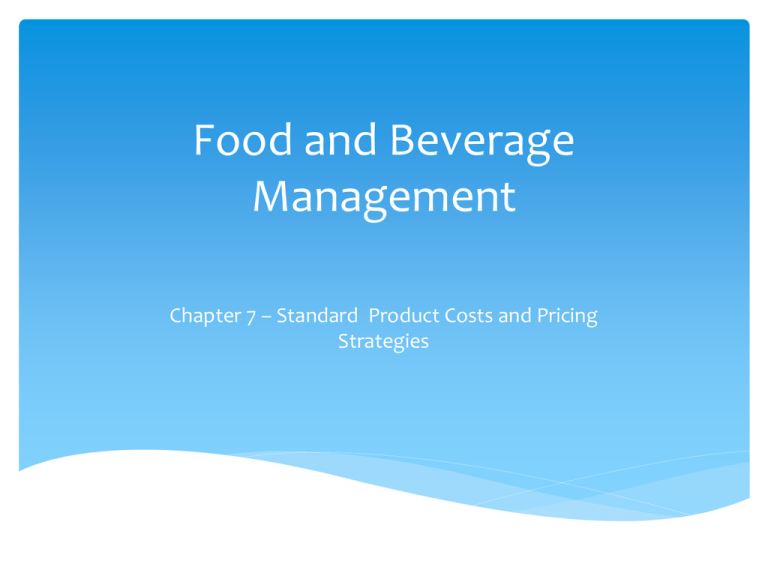
Food and Beverage Management Chapter 7 – Standard Product Costs and Pricing Strategies Planning Menus Managers must keep in mind target market and financial objectives of the company After determining price of ingredients – then can figure cost. Cost then can be translated into price Standard Recipes 3 Standard Recipes Most importantly – promotes consistency in Quality Flavor Portion Size Efficient purchasing practices More likely the correct amount is prepared Managers can more effectively schedule people and equipment Less Supervision is required Other employees (that can read) can follow recipes Chefs and Bartenders do not need to be present Can be computerized! Recipe Management Software Maintains 3 critical files 1. Ingredient File 2. Standard Recipe File 3. Menu Item File Ingredient File Contains data about each purchased ingredient Purchase unit ( ex. 50 lb case of shrimp in 10 (5 lb) Boxes Issue Unit (ex. 5 lb box and cost per unit issued) Recipe Unit ( ex. 3 lbs shrimp) Some files may have more than 1 recipe unit – sliced bread vs. breadcrumbs Standard Recipe File Contains Recipes for all menu items Easily scalable to yield desired quantities May contain subrecipes The inclusion of subrecipes in Standard files is called ”Chaining Recipes” Menu Item Files Used primarily by POS system Contains: Recipe Code number Selling Price Ingredient quantities Sales Totals Usually contain item’s sale history Computer Generated Recipe 9 Developing Standard Recipes Requires standardizing existing recipes – Develop implementation schedule Talk through preparation How much of each ingredient? What are exact procedures? Cooking/Baking Times? What portion control tools are used? Garnishes? Developing Standard Recipes Use standard format Establish desirable yield List all ingredients in order used Weights or Measures? Weights are more accurate Express quantities in practical amounts Record Procedures in detailed terms Provide Directions for portioning Pre-Costing and Adjusting the Recipes You’ve got to know your weights and measures! 12 Developing Standard Recipes TEST THE RECIPE!!! Minor changes/fluctuations can make big differences Baked items - changes in altitude or humidity Make sure everyone is in line with the program Make sure ingredients are available Review popularity and ease of use with customers and staff. Adjusting Standard Recipe Yields Yield can be increased or decreased using an Adjustment Factor Adjustment Factor = Desired Yield Original Yield Adjusting Standard Recipe Yields Example: Adjustment Factor = 225 portions (desired) = 2.25 100 portions (original) Multiply adjustment factor and original recipe amount New amount = 8 oz. X 2.25 = 18 oz Adjusting Standard Recipe Yields Same methodology is used to determine portions and volumes: Desired Portion = Adjustment Factor Original Portion Recipe yields (40) 12 oz portions – (40) 8 oz portions needed 8 oz = 0.67 12 oz Recipe original amount was 20 lbs 20 lbs X 0.67 = 13.4 lbs Adjusting Standard Recipe Yields Taste test – not as simple as math! Modify recipe until it yields desired volumes Adjust the recipe to provide portions for a specific pan size – then make it to the number of pans needed Determining Standard Portion Costs After Standard Recipes and portion sizes have been established, costs can be determined Standard portion cost is the cost to produce one portion of an item according to the standard recipe Meal Cost – is the total of all items included in the meal Determining Standard Portion Costs Is determined by dividing the sum of the ingredient costs by the number of portions If cost is $75 and yields 50 portions – Standard portion cost is $1.50 Determining Standard Portion Costs Standard Recipes & Costs 21 Determining Overall Standard Food Costs 22 Determining Overall Standard Food Costs Ideal Food Costs can be calculated Compare Theoretical to actual Bottom line profit is reduced by $1 for each $1 in higher food cost Low than anticipated needs investigation as well Portion Costs for Beverages Usually simple – few ingredients Most alcoholic beverages are sold by the liter Some need to convert liters to ounces 33.18 oz to 1 liter Cost per oz = price per bottle (unit) Ounces per bottle Drink Cost % = Drink cost Selling Price Beverage Cost Calculations 25 Pricing Menu Items Art of Pricing – intuition Reasonable Price Method – “If I were a guest – how much would I pay for this? Highest Price Method – go in high and back off Loss Leader Price Method Intuitive Price Method – WAG! Pricing Menu Items After determining desired food cost % Selling Price = Standard portion cost Desired Food cost % ex. 1 portion cost = $1.50, desired food cost % = 33% $1.50 = $4.55 (rounded) .33 Pricing Menu Items Elasticity of demand – relationship between selling price and demand Is Lower Food Cost % always the goal? Consider contribution Margin Pricing 29 Profit Pricing Profit Pricing method ensures that profit requirements and non food expenses are considered Allowable Food Cost = Forecasted Revenue – nonfood expenses – profit desired Calculate Budgeted Food Cost % Budgeted Food Cost % = Allowable Food Costs Forecasted Food Revenues Pricing Menu Items Example Forecasted Food Rev. – Non Food Exp – Profit Target = $310,000 $800,000 - $415,000 - $75,000 Allowable Food Cost $310,000 = .388 (39 % rounded) Forecast Food Rev. $800,000 Final Word Know your Market Know your Competition Elasticity of Demand – how price changes in response to demand.
